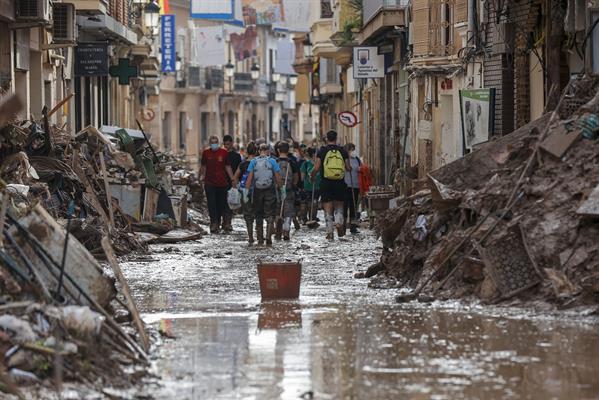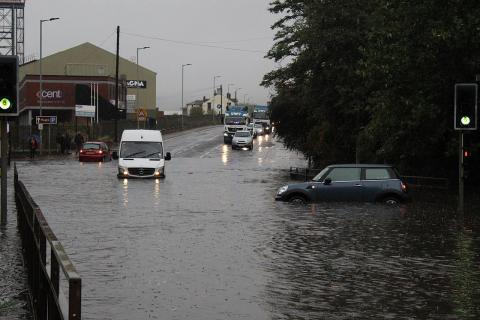The heavy rainfall of the Valencia DANA was mainly due to climate change, according to a study
A study by a team from the ClimaMeter project claims that the intensification of rainfall from the DANA that devastated Valencia and other regions on 29 October is mainly attributed to human-induced climate change. Natural climate variability, on the other hand, probably played a modest role. According to the analysis, this DANA was driven by very exceptional weather conditions. The work also shows that the DANA-like depressions that cause flooding in the southeastern peninsular are up to 15 % wetter than they were in the past. In addition, temperatures are up to 3°C warmer, which favours storm formation in these events over the Mediterranean basin.

Dominic Royé - atribución dana EN
Dominic Royé
Researcher at the Galician Biological Mission – CSIC
This is the second study, the first one by WWA (World Weather Attribution) on 2 November. The second study by ClimaMeter is consistent with the one published by WWA. In my view, there is no doubt that extreme events of this type are more likely now with anthropogenic climate change than they would be without it. Attribution studies put the numbers by how much an extreme event has become more likely or intense. We know that with every 1°C increase in global temperature, the amount of water vapour in the atmosphere can increase by about 7%. The more water vapour, the more intense these types of events can become.
One more point: drought and extreme precipitation are two sides of the same coin. Warmer temperatures increase evaporation, which reduces surface water and dries out soils and vegetation.
Pilar Brufau - estudio DANA Valencia EN
Pilar Brufau
Researcher and Lecturer in the Department of Materials and Fluids Science and Technology at the University of Zaragoza
The study presents a comparative analysis of the formation of a DANA such as the one that occurred at the end of October in Spain, with respect to what this same DANA would have been like in the past (1979-2001). This analysis, carried out by a team with extensive experience in extreme meteorological phenomena, within the ClimaMeter framework, is based on the observation of variables such as: surface pressure, temperature, precipitation and wind. The approach used is to look for similar weather situations observed in the past to assess the influence of climate change on the intensity and characteristics of the event. This methodology allows us to identify significant increases in precipitation and temperatures in the Mediterranean region, suggesting that global warming may have intensified the event and its impact. In this sense, studies such as this one are crucial to anticipate future events, especially in vulnerable regions such as the Mediterranean, where HLDD can have devastating effects in social and economic terms.
However, the study also has limitations that need to be considered. The authors themselves acknowledge that confidence in the robustness of this approach is low due to the exceptionality of the event in the historical data record. To compensate for this lack of direct comparability, they have had to extend the analysis to analogous events that, although similar, do not share exactly the same characteristics. This limitation in the availability of specific historical data reduces the precision with which the event can be attributed solely to anthropogenic climate change. Furthermore, the complexity of factors such as the Atlantic Multidecadal Oscillation introduces uncertainty as to whether the event is a response to natural climate variability alone or to the direct influence of global warming.
From a personal perspective, I believe that this type of study is essential to improve the predictive capacity for future extreme events. Modelling also plays an essential role in this anticipation, as improving the accuracy of models through high-resolution simulations and real-time analysis, based on observations of physical variables, would allow more accurate forecasting of the intensity and location of storms.
Markus Donat - DANA Valencia estudio EN
Markus Donat
ICREA Research Professor, Climate Variability and Change Group Co-Leader
This study analyses analogous meteorological situations under earlier (colder) and more recent (warmer) weather conditions. Because the weather situation of the recent DANA event was quite specific, there may not be enough similar weather situations in the historical record to allow a robust analysis of how this storm would behave under colder and warmer weather conditions. The authors acknowledge that the lack of comparable historical weather scenarios undermines the robustness of their analysis.
Nevertheless, the qualitative conclusions that storm systems in a warmer climate are associated with more intense precipitation are consistent with our scientific knowledge and are in line with previous IPCC reports. While it may be difficult to detect changes in the frequency of such weather events, it is safe to assume that when these weather events occur in a warmer climate, they may cause heavier downpours.
A warmer atmosphere can hold more water vapour, and a warmer Atlantic and Mediterranean can supply more moisture to the atmosphere through evaporation. More water in the atmosphere means heavier rainfall associated with storm systems such as the DANA that affected many areas of Spain last week.
Davide Faranda et al.
- Research article



